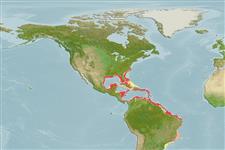Common names from other countries
Classification / Names / Names
Common names | Synonyms | Catalog of Fishes (gen., sp.) | ITIS | CoL | WoRMS
Environment: milieu / climate zone / depth range / distribution range
Ecology
Benthic; depth range 2 - 73 m (Ref. 83435). Tropical
Western Atlantic: Caribbean Sea, from Florida to Brazil.
Length at first maturity / Size / Weight / Age
Maturity: Lm ? range ? - ? cm Max length : 5.3 cm DL male/unsexed; (Ref. 83435); common length : 5.1 cm SHL male/unsexed; (Ref. 360)
Shell: convex valves, slightly inequivalved and inequilateral; coloration is cream or delicately pink; sculpture consists of a score of radialribs decorated with spines whose breadth progressively increases from the umbo to the ventral margin of the valve; between the ribs are small granulations, irregularly arranged; lunule is very differentiated and heart-shaped; ligament is external, hinge is pachyodont; two large muscle scars (posterior is bigger than the anterior; dimyarian, anisomyarian), pallial line is continuous with no sinus. Body: foot is reduced to keep with its sedentary life; mantle cavity has a pair of gills, each with two series of lamellae, extensively fused by interlamellar junctions (eulamellibranch).
Life cycle and mating behavior
Maturity | Reproduction | Spawning | Eggs | Fecundity | Larvae
Members of the class Bivalvia are mostly gonochoric, some are protandric hermaphrodites. Life cycle: Embryos develop into free-swimming trocophore larvae, succeeded by the bivalve veliger, resembling a miniature clam.
Sabelli, B. and H.S. Feinberg (eds.). 1879. (Ref. 360)
IUCN Red List Status (Ref. 130435)
CITES status (Ref. 108899)
Not Evaluated
Not Evaluated
Human uses
| FishSource |
Tools
More information
Age/SizeGrowthLength-weightLength-lengthMorphologyLarvaeAbundance
Internet sources
Estimates based on models
Preferred temperature
(Ref.
115969): 23.9 - 28, mean 26.7 (based on 214 cells).
Price category
Unknown.
